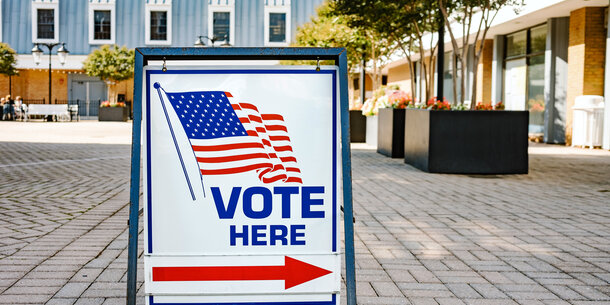The past year has been characterized by widespread assaults on voting rights across the country. This has been especially true in swing states where the 2020 presidential election saw narrow margins. As our colleague Will Wilder explains, even among these states, Arizona stands out as a focal point for the fight over voting rights.
Here, we look at one provision of Arizona’s Senate Bill 1485, which was passed into law in May 2021 but won’t be in effect for the midterms. The bill turns Arizona’s extremely popular “Permanent Early Voting List” into an “Active Early Voting List.” Voters on the list are automatically mailed a ballot before every election. Under the new rules, Arizonans will be removed from the list if they go four years without casting a ballot by mail. Even if a voter participates but only does so in person, they will fall off the list.
Like in much of the Western United States, Arizonans have a robust history of casting their votes by mail. Since 2010, an average of two-thirds of the electorate has voted by mail. Like four other states, Arizona has allowed voters to sign up to receive a ballot in the mail for all elections, obviating the need to fill out a new absentee ballot request form for each and every contest. According to voter file data from L2 Political, some 3 million Arizonans (roughly 75 percent of the electorate) were on the list in April of 2021, shortly before S.B. 1485 was passed.
To analyze the expected effects of the law, we looked at voter file data from L2 Political, which records whether and how each voter participated in an election. Although voters won’t be removed from the list for a few years, we wanted to know who would be impacted based on the list as it was when the legislature was considering this change. To do so, we looked at which voters on the list cast a mail ballot in any election in 2017, 2018, 2019, or 2020. If they voted by mail in any of these elections, they are considered “not at risk” of being dropped; they are considered “at risk” if they did not cast a mail ballot.
In Arizona, voters do not self-identify their race or ethnicity when they register to vote. To estimate each voter’s race or ethnicity, we use a technique common among political scientists called Bayesian Improved Surname Geocoding, which predicts race/ethnicity based on each voter’s last name and the demographics of the census block in which they live. This method is widely used by academics and voting rights litigators alike to predict racial/ethnic demographics. While it cannot perfectly estimate any individual’s race or ethnicity, it has very low error rates at the population level. (This method considers “Latino” to be mutually exclusive from other races and ethnicities — put differently, a voter is considered either white or Black or Latino.)
To be clear, being dropped from the permanent early voting list doesn’t mean that a voter will be disenfranchised. They’ll receive a notice from the state indicating that they’ve been removed and can then either reenlist or vote in person. However, many voters might miss the notification in the mail — and mail delivery is not always reliable. As such, some people might not end up voting if they don’t receive their expected mail ballot. And for all voters, the requirement to rejoin the list of mail voters imposes the sort of small costs that can add up to major burdens on the right to vote — a problem under any circumstances, and doubly so when the costs have such clear racial disparities as the Arizona bill.
The chart below shows the share of each racial/ethnic group that is at risk of being dropped from the early voting list. About 11.6 percent of voters — or more than 340,000 Arizonans — are at risk of being removed, but there are clear racial disparities. While just 8.4 percent of white voters on the list went four years without voting by mail, this was the case for more than 21.1 percent of Latino voters.
This adds up to big discrepancies in the overall number of voters who could be dropped when broken down by race and ethnicity. Although 31 percent of voters on the list are nonwhite, these voters make up half of those at risk of being dropped. All nonwhite racial groups are overrepresented among those at risk of being removed, but none as much as Latino voters.
Latino voters make up just 17 percent of the permanent early voters who aren’t at risk of being dropped but more than a third of those who might fall off the list. The figure below shows the relative risk ratio that each racial group faces of being removed from the list. If a group’s share of the at-risk population is equal to its share of the total population, the group’s risk ratio is 1. A risk ratio above 1 indicates that a given group is overrepresented in the at-risk population. As you can see, each racial/ethnic group except for white Arizonans is above 1 (although the risk ratio for Asian American voters is very close to 1).
Undermining the permanent early voting list also spells danger for Arizona’s Native American communities. Because Native Americans make up a relatively small share of the population, it is often difficult to identify them using techniques such as surname geocoding. As an alternative, we used the geocoded voter file and census shapefiles to identify voters who live on Native American tribal lands. To be sure, this misses Native Americans who live off reservations. Nevertheless, it is helpful to know whether individuals living on reservations are disproportionately harmed by the new law.
The difference is stark: about 23 percent of voters on the list who reside on tribal lands are at risk of removal, compared to only 11.6 percent of permanent early voters statewide. In other words, voters on tribal lands are more than twice as likely to face removal.
These results make plain that S.B. 1485, like so many other policies that restrict access to voting, will have a disproportionate effect on voters of color and Native American voters.




